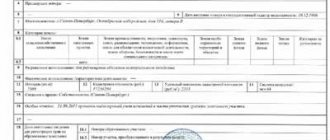What is it and what is it for?
The boundary plan is the main document on the basis of which data on a land plot is entered into the State Real Estate Cadastre. The document is drawn up on the basis of a cadastral plan or a cadastral extract from the land plot. The land survey plan contains information about changes to the boundaries of the site, its parts and the site itself. The data entered into the MP is needed to register the land plot for cadastral registration.
The exact description of the form and composition of the document on the formation of a landowner is specified in the order of the Ministry of Economic Development No. 921 dated December 8, 2015.
The boundary plan can be drawn up in both paper and electronic forms. For the electronic form, an electronic signature of the cadastral engineer is also required.
The MP itself is required to obtain a cadastral passport. A cadastral passport is a mandatory document when making any transactions with a land plot, including:
- donation;
- purchase and sale;
- exchange;
- will.
Reasons for creating or updating a survey plan:
- creation of land plots from state or municipal lands;
- combining several neighboring areas;
- allocation of a plot of land in common ownership;
- section of the site;
- detection and correction of errors in cadastral registration;
- redistribution of plots.
If an MP is created on the basis of a merger of neighboring plots, then an “Act of Approval” is additionally attached to it, where all interested parties are required to sign.
Certificate of approval
After the owners of neighboring plots are properly informed, the land surveying procedure itself takes place. During it, the cadastral engineer answers questions and provides explanations to interested parties. The result of the work is an act of approval. According to the rules, it is drawn up on the reverse side of the drawing.
For it to gain legal force, it must contain the signatures of neighbors. In this way, they will confirm that they have no complaints about the work performed and agree with the established boundaries. If one of the owners was unable to be present in person, and an elected representative will sign on his behalf, his powers must be confirmed by a power of attorney.
If any of the interested parties is absent, a note is made about this. At the same time, evidence of his notification is sewn into the case. If anyone present does not agree with the results, he has the right to refuse to sign the document. The refusal is also recorded along with justification of the reasons (according to the words of the neighbor or written claims from him). The act is also signed by the owner of the site and the responsible person who carried out the survey.
As a result, the finished act must contain:
- surname and initials of the interested persons, as well as their passport details;
- approval results;
- final diagram of the boundaries of the land plot with geographical coordinates;
- if there are any, objections based on the results of the work performed;
- signatures of all meeting participants;
- signature and seal of the cadastral engineer;
- visa from the department of architecture or administration of a rural settlement.
What does a land surveying project and its contents look like?
A standard boundary plan consists of two parts: text and graphic. Each part is also divided into sections. The paper version of the boundary plan is left on several sheets of A-4 format.
The graphic part is allowed to be compiled on larger format sheets. The MP in paper form is drawn up in at least two copies.
Text part
The text part is written on several sheets. If all the information is not reduced on one sheet, then you can write on the reverse side, but “Landing plan” must be written on each page. Continuous numbering of document pages is required. The text part includes:
- general information, as well as the immediate purpose of cadastral work;
- initial data, a list of documents that were used during the work;
- information about geodetic survey;
- information about the land plot and its parts, as well as about the real estate that is located on it;
- the listed work performed, how exactly the coordinates of characteristic points were determined, the boundaries of the site, measurement accuracy, area;
- a separate section for modified areas;
- section for new sites;
- possibility of access to the described area;
- conclusion of a cadastral engineer;
- act of approval.
If the site is just being formed, then the address, category of land, type of use, data from the Unified State Register, and cadastral number of the property are indicated.
The grafical part
The graphic part is also mandatory and includes several subsections:
- designation scheme for geodetic constructions;
- drawing of the site itself;
- site layout diagram;
- description of the outlines for the nodal points of the memory.
Depending on the type of land surveying plan, the mandatory and additional subsections vary.
Here's what a sample land plot plan looks like as an example:
Land survey after the beginning of 2021
It is recommended to carry out this procedure before the beginning of 2021. Regardless of when the request occurred, the cost is determined by the company from which the survey is ordered. The use of the dacha amnesty will end from the beginning of next year. This suggests that the procedure will be applied in the usual manner, and not in a simplified manner. There are no changes to the process in question in 2021. In a situation where a citizen does not plan to make any transactions in relation to real estate, he has the right not to delimit it.
ATTENTION !!! It is important to take into account that various types of situations may occur in practical activities. For example, the legal successors of a deceased citizen apply to the authorized bodies. These persons lay claim to the house and allotment. The registration of documentation for these objects occurred a long time ago, so the boundaries were not determined, cadastral numbers were not assigned to the plot. The deceased began doing dacha work in the spring and finished it in the fall. After the death, the main question arose - the process of land surveying. The heirs will have to perform a series of sequential actions in order to be able to dispose of the land.
Such situations currently arise quite often. For this reason, citizens turn to specially created companies so that employees can carry out the land surveying process from the very beginning to completion.
Kinds
According to the existing Land Legislation, there are 7 types of land survey plans. These include:
- A type that specifies the boundaries of the site and its area. Necessary if the cadastral registration system does not have enough information about a specific land plot.
- A plan for clarifying boundaries when allocating land from state or municipal lands.
- A plan to provide information about a site that is separated from common shared ownership.
- Plan after combining several sections into one (multi-circuit).
- Information on the redistribution of plot boundaries.
- Plan for correcting cadastral errors and inaccuracies.
- A plan reflecting information on the results of dividing the site into several.
Each type of MP has its own mandatory information to be entered.
Notifying neighbors
Most often, the site where land surveying is required borders on the sites of other owners. If none of them have carried out land surveying yet, it is necessary to agree on the established boundaries with them. This will require documentary evidence that the parties concerned received the notice. Otherwise, they will have grounds for litigation to re-establish the boundaries between the plots.
If one of the neighbors has already carried out land surveying, there is no need to coordinate the border with his plot.
The notice states:
- Full name of the owner of the site where land surveying is being carried out and his contact information;
- Full name and contact details of the cadastral engineer;
- information about the site: location and cadastral number;
- where and when you can get acquainted with the draft boundary plan;
- the place and time of the meeting at which stakeholders will agree on boundaries;
- the address where comments and objections can be sent, as well as the deadline for filing claims.
- How and where to check the cadastral number of a land plot?
To notify neighbors, you need to give them a notice against signature. If neighbors refuse to sign, this fact must be recorded. This will be considered sufficient, and even if they do not come and sign the agreement, it will be difficult for them to challenge the results of the land survey later.
If it was not possible to find your neighbors in person, the following methods of notification are possible:
- By registered mail with acknowledgment of delivery. If there is no response, it is recommended to repeat the sending twice more. It doesn’t matter whether the person simply did not respond to the letter or whether it was returned without being delivered to the addressee - confirmation of dispatch will be sufficient in the event of possible legal proceedings. But if a neighbor has raised concerns about the procedure, you will need to resolve differences with him.
- By phone call or email. But it can be difficult to prove that a person received information transmitted in this way, especially if he claims the opposite.
- When it is impossible to contact neighbors and there is no information about their whereabouts, it is allowed to notify about the place and time of agreement through publication in local media.
Interested parties must be notified at least a month before the approval procedure. If the neighbor said that he will not be able to be present and personally sign the act, but has no complaints about the results of the land survey, you can ask him to send written consent or issue a power of attorney for the representative. All documents on notification of interested parties and their responses must be preserved. Subsequently, they will be attached to the approval act.
If desired, the owner can carry out the approval not at a general meeting, but personally go around all the neighbors and ask them to sign the prepared act. But if the neighbor refuses to sign for it, you will need to organize an official procedure with sending out notifications.
Difference from geodesy
Geodesy and land surveying are fundamentally different, but interconnected procedures for clarifying the boundaries of a site.
- Geodesy involves topographic surveying of the area, and at the same time the customer receives a completed topographic map on a certain scale.
- Land surveying has a clear connection to the area by determining the shape of the site, its boundaries, area, as well as the mandatory clarification of information on real estate located on the site.
After the surveying procedure, all received data is registered in the Register. Geodesy does not assume this. In geodetic work, all information is of a purely general nature.
Difference with privatization
These are different procedures.
- The land surveying process involves clarifying the boundaries of the site and creating a drawing for a specific site with all the necessary data entered into the land survey plan.
- Privatization is the transfer of state or other lands into ownership free of charge with subsequent registration of the owner’s rights.
It is important to understand that surveying a plot of land does not make a person its owner. To do this, you need to collect and submit a certain list of documents, among which will be a land survey plan.
How long will it take to prepare the boundary plan?
It is impossible to say the exact timing of drawing up the boundary plan. They depend on a variety of cases. Time determines many different nuances. For example, when ordering a boundary plan, you may not know some information, so it will take time to figure it out, there may also be problems with rights, etc. Typically, drawing up a boundary plan takes from 2 weeks to 1 month. The contract is concluded in about one day, and all the documentation you provided is checked in the same amount of time. It usually takes from 3 days to 2 weeks to receive a cadastral extract and CPT. If field work is needed, it will take approximately one day. Then all measurements are processed and approval acts are prepared. This usually takes about 2 days.
The boundaries of the land plot are agreed upon from 5 days to a month. But this is only in cases where it is required. The boundary plan is finally formed in about 2 days. The timing may vary, since sometimes a specialist visit is not required. Sometimes you don't need to agree on boundaries. If absolutely all the documents and measurements are collected, then it may take only a few days to prepare the plan. Sometimes just one day.
If you need to know the exact timing, as well as the cost of preparing a boundary plan, then you should contact our consultant. He will provide you with all the necessary information.
Of course, all these numbers are inaccurate, you just have to rely on them. No one can give you a guarantee on the accuracy of the deadline, since everything is very individual. If there are any disagreements, the formation of the plan may be very delayed.
In the worst case scenario, there may even be a lawsuit. Therefore, before contacting a specialist, you need to collect the entire list of documents and make sure that no problems arise.
Step-by-step instructions: where and how can I get MP?
To obtain a Landmark Plan, which fully complies with all legal requirements, you must contact specialized organizations, which is a paid service. The cost of land surveying depends on the area of the land plot.
Documents for registration
To obtain a land survey plan, you must provide the following documents:
- a document certifying the rights to this land plot;
- certificate of ownership of the site;
- a copy of the site master plan;
- cadastral passport of the land plot;
- owner's civil passport.
If representatives act in the interests of the copyright holder, then you need to have a notarized power of attorney, as well as the passport of the representative himself. If the plot is in shared ownership - an agreement left and signed by the participants in shared ownership.
State duty for production
To formulate a plan, you must contact either the Department of Architecture and Urban Planning or private organizations.
All issues related to payment of the state duty for registering agricultural land plots for cadastral registration are stipulated in Art. 333.33 Tax Code of the Russian Federation:
- when registering 1 subject of property - for individuals 2000 rubles, for organizations - 22 thousand;
- for memory – 350 rubles;
- to make changes to the Unified State Register – 350 rubles.
There are categories of citizens exempt from paying state duty:
- low-income people according to the provisions of the Housing Code;
- federal, municipal and regional authorities.
All others must pay the state duty in full.
In addition to the actual fees, it is necessary to pay for the work of the cadastral engineer. The cost depends on the area of the site and differs depending on the region and the specific organization that performs the survey.
Conclusion of an agreement
The contract for the work must be concluded with a licensed geodetic firm. The contract must specify the terms, as well as the cost of the work performed and the payment procedure between the parties.
The subject of the contract is a specific list and scope of boundary measures to be carried out, which regulatory act will guide the engineer when carrying out the work.
Coordination with neighbors
This is another essential part of preparing a plan. It is necessary to leave a document in which the area and boundaries of the copyright holder's plot will be marked with a red line on the general plan sketch.
Each owner of a neighboring plot must personally sign this document. If there are neighbors who refuse to sign the act, you will have to go to court.
Disengagement procedure
The demarcation procedure is carried out between the owners of the same plot, between a group of owners, between neighbors, when overlapping boundaries arise. After the demarcation procedure is completed, a separate document is generated for each individual section.
Demarcation of land for housing construction makes it possible for apartment owners to secure rights to the land under the house.
Entering information into Rosreestr
In addition to the received cadastral plan, the following documents will be needed to register the land plot:
- confirmation of ownership rights;
- foundation documents: purchase and sale agreement, donation, lease, will;
- original geodetic plan;
- the original power of attorney, if the registration is carried out by an authorized person;
- document from the Guardianship authorities, if the owner is a minor.
Before registering the cadastral plan, you need to pay a state fee in the amount of 200 rubles for citizens and 600 rubles. for companies.
At Rosreestr, submit the entire package of documents to an authorized employee and receive a receipt. If all the documents are numbered, then the land plot will be registered and assigned a cadastral number. If it is necessary to make changes, the registration may take from two to 6 months.
The procedure for approving the boundaries of a land plot - surveying or removing points
If your plot is not located in an “open field”, you will need to agree on land surveying with your neighbors. They (plus the Chairman of the Board, if you have a plot in a garden/dacha association) will have to confirm in writing that they agree with the boundaries of the plot. You must notify the neighbors/chairman yourself.
Therefore, although we wrote that the presence of the owner of the property during the procedure is not required, it may be better for you to come to the place. After all, the neighbors/chairman must be there to sign the appropriate signatures. To avoid misunderstandings, it is better to check everything yourself.
“Territorial disputes” with neighbors must be resolved in advance. If this is not possible, record the fact of refusal in writing, look for all old documents indicating your right to the disputed “pieces,” hire an experienced lawyer and go to court. This is a long and expensive business.
Therefore, if we are talking about a couple of really controversial square meters, sometimes it is preferable to give in in order to save yourself from unnecessary hassle and costs. If the neighbor has “completely lost his conscience” - sue.
Judicial practice is optimistic - most of the justified claims of the plaintiffs are satisfied.
How to watch?
There are 2 ways to view the land survey plan for the land plot of interest.
By the address
If you need to look at the plan of a land plot, knowing only its address, just go to the website of the Public Cadastral Map https://egrp365.ru/map/. Then the algorithm of actions is simple:
- enter the address in the window located in the upper right corner and click “Find”;
- wait a while for loading.
As a result, a window will open indicating the cadastral number of the land plot, land category, area, as well as the fact of the procedure. If you left-click on the selected area on the map, you can get all the information about this memory.
How to clarify boundaries if there is a cadastral number?
On the same website it is possible to enter the cadastral number and then the system will provide a land survey plan. The window for entering the cadastral number is located above the window with the address. There is also a developed program specifically for smartphone owners.
Land surveying is a necessary procedure for accurately determining boundaries and resolving all disputes. Without this document, you cannot perform any action with real estate, including donation and sale. The land surveying plan must strictly comply with legal requirements and have both text and graphic parts with all data.
We tried to write the best article. If you liked it, please share it with your friends or leave a comment below. Thank you! Great article 8
Is it possible to challenge the land survey of your own or a neighboring plot?
Of course you can, if there is a legal basis. You just have to follow a certain sequence of actions:
- First of all, file a complaint with your local administration.
- If the administration is inactive, get a written refusal from the officials to satisfy your material rights and contact the Prosecutor’s Office
- If the Prosecutor’s Office also receives a refusal to file a complaint, file a statement of claim with the court.
Trial proceedings require careful preparation. We recommend using the assistance of experienced land law lawyers.
Initial free consultations are available on the prav.io website. possible at any time of the day.
A lawyer found on the site can also help in preparing the necessary documents (including the claim itself). And if he lives in the same city with you, he can undertake representation in court and full protection of your rights.











